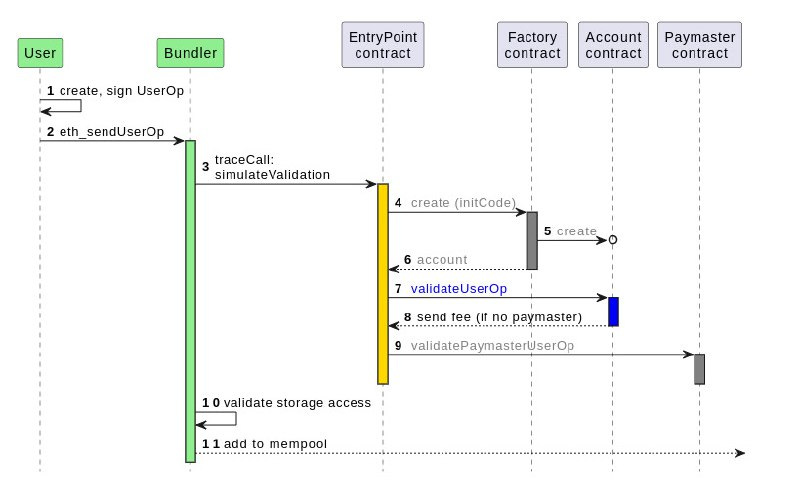Account abstraction is a groundbreaking concept in the Ethereum ecosystem that aims to improve user experience, enhance security, and enable more flexible account management. In this article, we'll explore the inner workings of account abstraction as defined in ERC-4337, focusing on its key components and mechanisms.
The Core Concept
Account abstraction allows users to interact with the Ethereum network using smart contract wallets instead of Externally Owned Accounts (EOAs). This approach brings several benefits:
Custom verification logic
Improved security features
Simplified user onboarding
Flexible fee payment options
Key Components of ERC-4337
1. UserOperation
The UserOperation is the central structure in ERC-4337. It's a data object that represents a transaction a user wants to execute. Unlike traditional Ethereum transactions, UserOperations are not directly included in blocks. Instead, they are bundled and executed through an EntryPoint contract.
Key fields in a UserOperation include:
sender: The account initiating the operationnonce: Anti-replay parametercallData: The actual operation to be performedsignature: Authorization data for the operationpaymasterData: When transaction fee is paid by paymaster contract
2. EntryPoint Contract
The EntryPoint is a singleton contract that serves as the main interface for executing UserOperations. It handles the validation and execution of operations, ensuring that only authorized actions are performed.
Key functions of the EntryPoint include:
handleOps: Processes a batch of UserOperationssimulateValidation: Used by bundlers to verify operations before inclusion
3. Bundlers
Bundlers are specialized actors in the ERC-4337 ecosystem. They collect UserOperations from a dedicated mempool, bundle them together, and submit them to the EntryPoint contract for execution. Bundlers play a crucial role in optimizing gas costs and ensuring efficient processing of operations.
4. Paymasters
Paymasters are contracts that can sponsor transaction fees for users. This feature allows for innovative models where dApps or third parties can cover gas costs, enabling gasless transactions for end-users.
The Account Abstraction Flow
UserOperation Creation: A user initiates an action, which is encoded as a UserOperation.
Mempool Submission: The UserOperation is submitted to a specialized mempool, separate from the regular Ethereum transaction pool.
Bundling: Bundlers monitor the mempool, collect multiple UserOperations, and create a bundle.
Validation: The bundler simulates the execution of the bundle using
simulateValidationto ensure all operations are valid.On-chain Execution: The bundler submits the bundle to the EntryPoint contract using
handleOps.EntryPoint Processing: The EntryPoint contract processes each UserOperation in the bundle:
It verifies the operation's validity by calling
validateUserOpon the sender's account contract.If a paymaster is specified, it validates the paymaster's willingness to pay for the operation.
It executes the operation's
callDataon the sender's account.
Fee Payment: The EntryPoint handles fee payment, either from the user's account or through the specified paymaster.
Advanced Features
Signature Aggregation
ERC-4337 supports signature aggregation, allowing multiple UserOperations to be verified with a single aggregated signature. This can significantly reduce gas costs for batched operations.
Social Login Integration
Account abstraction enables seamless integration of social login mechanisms, significantly improving the user onboarding experience. With ERC-4337, wallet implementations can incorporate various authentication methods, including:
OAuth: Users can authenticate using their existing social media accounts (e.g., Google, Facebook, Twitter).
Email-based verification: Simple email-and-password combinations can be used for account access.
Biometric authentication: Leveraging device-level security features like fingerprint or face recognition.
This flexibility allows for familiar authentication flows, reducing the barriers to entry for new users in the blockchain space. The smart contract wallet can be designed to accept these alternative authentication methods, translating them into on-chain actions through the UserOperation structure.
Moreover, social login can be combined with more traditional crypto-native security measures, creating a multi-factor authentication system that balances user convenience with robust security.
Reputation System
To prevent denial-of-service attacks, ERC-4337 implements a reputation system for paymasters and other entities. This system helps maintain the integrity of the mempool and protects against malicious actors.
Conclusion
Account abstraction, as defined in ERC-4337, represents a significant leap forward in Ethereum's account model. By separating transaction authorization from execution and introducing flexible fee payment options, it paves the way for more user-friendly and secure blockchain interactions.
While the implementation is complex, involving multiple new components and actors, the benefits it brings to the ecosystem are substantial. As this standard gains adoption, we can expect to see a new wave of innovative wallet designs and user experiences in the Ethereum ecosystem.
References:
1. https://eips.ethereum.org/EIPS/eip-4337
2. ERC-4337 Documentation – ERC 4337 Documentation
3. Learn Account Abstraction - Resources and Education (alchemy.com)




